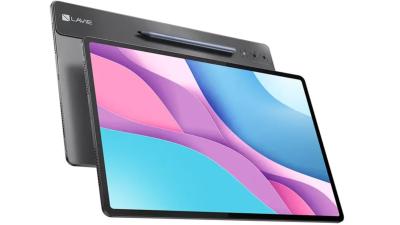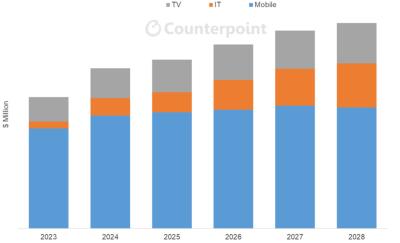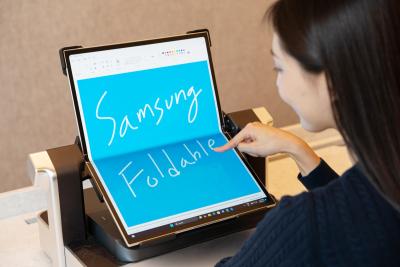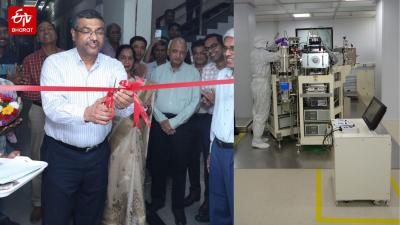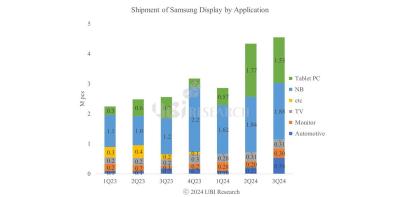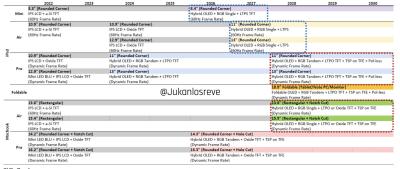OLED Tablets - Introduction and Latest Industry News
What is an OLED display?
OLED is short for Organic Light Emitting Diode, a device composed of thin carbon-based films placed between two electrodes that creates light with the application of electricity. Unlike other screen technologies, (like LCDs), which require backlighting, OLED displays are emissive devices - they emit light rather than manipulate transmitted external light.
OLEDs provide brighter, crisper colors and contrast on electronic devices and use less power than conventional light-emitting diodes (LEDs) or liquid crystal displays (LCDs) used today. This revolutionary technology is fit for various types of screens, like computer screens, mobile phones, tablets, TVs and more. OLED screens are light, thin, high-resolution and contain individually-lit pixels that make for true blacks and superior color contrast.
The current OLED tablet market
OLED displays are already very common on mobile phones (in fact it is the dominant technology, with a market share of over 50%), as Apple, Samsung, Vivo, Xiaomi and others adopt OLED displays in their smartphones.
OLEDs are also used in tablets, and this is a growing market. Samsung, Microsoft, Huawei and others are already shipping OLED-powered tablets. In 2024 Apple launched its first OLED tablets, the 2024 iPad Pro devices. It is likely that Apple's move will cause an increased adoption of OLEDs in tablets from other companies.
Click here for a full list of the latest OLED tablets on the market.
DSCC: the OLED materials market grew 22% in 2024, Chinese material makers enjoy a sharp increase in demand
DSCC (now part of Counterpoint) says that OLED evaporation material sales will grow 22% in 2024, and will continue to grow at a 6.4% CAGR from 2024 to 2028. Most of the growth will come from IT display panels, for laptops, monitors and tablets.
Interestingly, DSCC estimates that Chinese material developers enjoyed a 58% increase in sales in 2024 to $252 million. The primary reasons for this sharp increase in demand is increased utilization at Chinese AMOLED fabs, increased orders from local companies in China over sourcing these materials from the rest of the world, and new range of materials introduced by materials makers (as Chinese material developers move from intermediates production to emitters and dopants).
LG Display to retrofit its iPad AMOLED line to produce iPhone OLEDs as Apple reduces its tablet display orders
In late 2024 we reported several times that demand for Apple's iPad Pro devices is lower than expected, and the company reduced its OLED panel orders from both Samsung and LG.
According to a new report from Korea, LG may decide to start using its IT AMOLED production line to produce smartphone displays. The company looks to supply 70 million iPhone AMOLED displays to Apple in 2025, up from around 65 million in 2024 (and 52 million in 2023). Converting the IT AMOLED line to smartphone panel production will enable LGD to increase capacity without a large investment in new equipment.
Samsung Display shows new OLED technologies at CES 2025
Samsung Display is set to show new OLED technologies at CES 2025, including new foldable display, rollable ones, automotive displays, next-gen QD-OLED panels and more.
So first up, Samsung will be showing a 18.1 foldable OLED display (which it says is the world's largest). This panel is suitable for IT devices - to enable devices that combine tablet, laptop and monitor devices into one. When folded, this display is 13.1" in size.
India inaugurates a new AMOLED research center at IIT Madras
The Indian Institute of Technology Madras (IIT Madras) has inaugurated a new research center dedicated for the development of AMOLED technologies. The new AMOLED Research Centre (ARC) is a national centre of excellent that is funded by the Government's Ministry of Electronics and Information Technology (MeitY), by the Indian Defence Research and Development Organisation (DRDO), and Tata Sons.
The goal of this new center is to help India's display manufacturing industry. It will focus on AMOLED displays for wearables, smartphones, and tablets. Researchers at the ARC will also engage in research into OLED TVs, OLED lighting and OPVs.
UBI: Samsung's automotive OLED shipments rise, but sales of tablet OLED displays are soft
UBI Research says that Samsung Display's medium and large OLED panel shipments in Q3 2024 were the same as in the previous quarter. Shipments of tablet OLED devices were low, but this was offset by increased sales of automotive displays. Compared to 2023, total medium and large OLED panel shipments more than doubled, mainly due to increased sales of tablet panels to Apple, and increased laptop OLED shipments.
UBI estimates that SDC's tablet PC sales decreased by 38% compared to the previous quarter. Automotive OLED shipments rose from 100,000 units in Q1 2024 to around 500,000 in Q3.
UBI: Apple reduces its iPad AMOLED orders from Samsung and LG as demand for its tablets is low
UBI Research estimates that Apple suffers from poor demand for its iPad Pro devices, and the company has reduced its orders from LG Display and Samsung Display. We heard signs of that already back in August.

UBI estimates that LG Display's medium to large sized OLED panels shipments decreased 34% in Q3 2024, compared to the previous quarter. Samsung Display's tablet OLED panel sales dropped 38% in the quarter. Samsung however enjoyed higher sales of automotive OLEDs, which means that its entire medium-to-large sales were flat in the quarter.
Omdia updates its Apple laptop and tablet adoption forecast, with new devices arriving in 2026 - and Apple's first foldable laptop by 2028
Omdia has updated its Apple iPad and Macbook display roadmaps, with new forecasts and information about Apple's OLED adoption plans in its IT product lines.
According to Omdia, Apple's iPad Mini will get a 8.4-inch LTPS OLED display in 2026. In 2027, Apple will also introduce OLED displays in its iPad Aid models (11-inch and 13-inch). In 2028 Apple will revamp the OLED displays in its iPad Pro models, offering a tandem architecture, polarizer-free OLED design and LTPO backplanes.
Omdia: large-area OLED panel shipments to grow 116.5% in 2024, and 32.7% in 2025
Omdia estimates that shipments of OLEDs over 9-inch in size (which Omdia defines as large-area OLEDs, although most companies will refer to these sizes as medium-sized OLEDs) will increase 116.5% in 2024, and will rise a further 32.7% in 2025.
This growth is driven by increasing demand for OLED monitors, tablets and laptops.
Huawei launches the Mate 70 smartphone family, the Mate X6 foldable and a new tablet - all with high end AMOLED displays
Huawei announced several new devices yesterday, all with AMOLED displays. We'll start with the Mate X6, a foldable smartphone that offers a 7.93" 120Hz 2240x2440 foldable LTPO AMOLED display, and a 6.45" 120Hz 1080x2440 LTPO AMOLED cover display.
Second is Huawei's new Mate 70 smartphone family, with 3 models. The basic Mate 70 has a 6.7" 2500 nits 120Hz 1216x2688 LTPO AMOLED display, while the 70 Pro and 70 Pro+ both sport a larger 6.9" 1316x2832 LTPO AMOLED displays. The interesting Mate 70 RS Ultimate edition that has a 6.9" 120Hz 3,500 nits 1316x2832 tandem LTPO AMOLED.
Applied Materials launches a maskless OLED production technology, to support 8-Gen high efficiency OLED deposition and encapsulation
Applied Materials announced a technology, branded as MAX OLED that enables OLED display production on large glass substrates, aiming to provide a cost-effective solution to produce TV and TV displays. Applied developed and patented a new OLED pixel architecture and a "dramatically different manufacturing approach" that the company says enables brighter, clearer, more energy-efficient and longer-lasting.
Applied's new MAX OLED systems can scale from 6-Gen substrates to 8-Gen substrates, supporting the new wave of IT OLED production lines. Applied says that its new solution has strong customer interest - and already achieved repeat orders from several leading display makers (see below). Specifically, Applied announced that it will supply an R&D system to Samsung Display that will test the new production technology for its AMOLED and QD-OLED production technologies.
Pagination
- Page 1
- Next page
